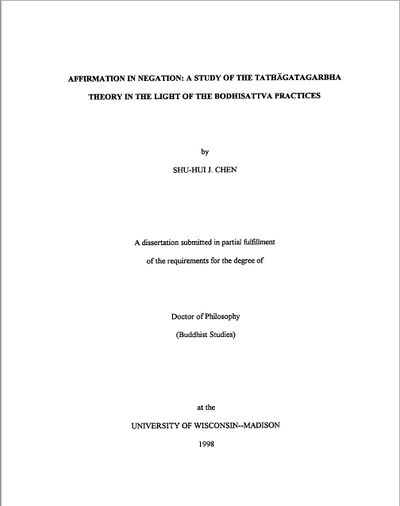Affirmation in Negation: A Study of the Tathāgatagarbha Theory in the Light of the Bodhisattva Practices
< Books(Redirected from Affirmation in Negation: A Study of the Tathāgatagarbha Theory in Light of the Bodhisattva Practices)
The Tathāgatagarbha theory, also known as the Buddha-nature theory, is one of the most influential Mahāyāna doctrines in the East Asian Buddhism. In 1989, it was severely criticized by some Japanese scholars, namely, Shiro Matsumoto and Noriaki Hakamaya, for being contradictory to the Buddha's teaching of non-self (anātman) and accused of being a non-Buddhist theory in disguise. The purpose of this study is to refute such an accusation and to demonstrate the relationship between this theory and the Bodhisattva practices which are the very core of the Mahāyāna Buddhism.
This dissertation begins with definitions of the term "tathāgatagarbha" and some of its synonyms which are followed by a brief review of the historical development of the Tathāgatagarbha theory from India to China. With these as the background knowledge, it is easier to point out the fallacies of the two Japanese scholars' criticism on this theory. A key issue in their criticism is that they viewed the Tathāgatagarbha theory as the ātman of the Upaniṣads in disguise. It is therefore necessary to discuss not only the distinction between the ātman mentioned in the Tathāgatagarbha theory and that in the Upaniṣads but also the controversy over the issue of ātman versus anātman among the Buddhist scholars.
In the discussion to clarify the issue of ātman in the Tathāgatagarbha theory, it is demonstrated that the ātman in the Tathāgatagarbha theory is not only uncontradictory to the doctrine of anātman in Buddhism but very important to the Bodhisattva practices in the Mahāyāna Buddhism. It functions as a unity for the Bodhisattvas to voluntarily return to the world of saṃsāra again and again. Furthermore, the purport of the entire theory, that all sentient beings are endowed with the essence of the Buddha, supports various Bodhisattva practices such as the aspiration to save all beings in the world, the six perfections, etc. In a word, the Tathāgatagarbha theory is an excellent representative of the soteriology of the Mahāyāna Buddhism. Included in the end of this dissertation is an annotated translation of the Tathāgatagarbha-sūtra. (Source Accessed May 26, 2020)
| Citation | Chen, Shu-hui Jennifer. "Affirmation in Negation: A Study of the Tathāgatagarbha Theory in the Light of the Bodhisattva Practices." PhD diss., University of Wisconsin-Madison, 1998. |
|---|---|

